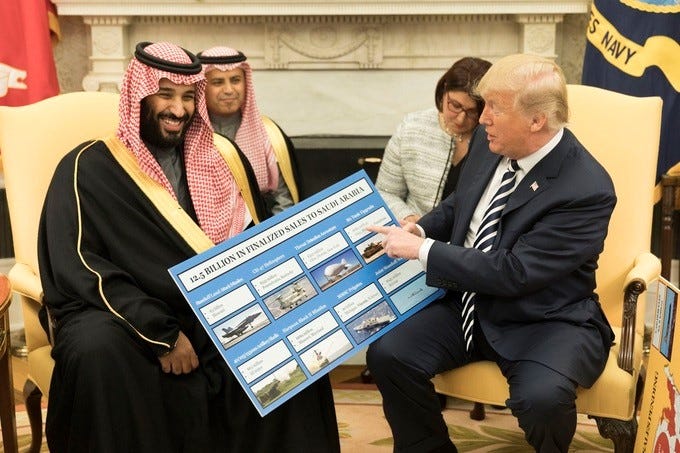Saudi oil bombings, what happens next?
Will the Iran-US rapprochement continue despite the bombings?
Friday, September 20, 2019
Political Disruption brings you insights on how the fast-changing global political environment is creating a political disruption of business.
Good Morning!
We didn’t plan to have a new Iran-related issue this week after our Iran update last week, but hey we can’t choose what’s happening in the world, and this bombing of Saudi oil infrastructure is quite significant.
Welcome to a new week of Political Disruption!
Hans Diels (you can also follow me on Twitter: @hans_diels)
Iran Risk Update
↑ Increased risk of escalation
Risk: The alleged Iranian involvement in the bombing of Saudi oil relations made plans for a US Iran rapprochement more complicated. However, the (relatively) cautious response from the White House shows that the softer approach of Iran is not completely gone. We expect limited retaliation by the US (increased sanctions + potential cyber-attacks). Further escalatory steps by both parties can still get them in an accidental conflict. New small scale attacks from Yemen an Saudi Arabia or the United Arab Emirates are also a possibility
Potential disruptive impact: An escalation of the conflict would actively disrupt maritime traffic in the Gulf and will have an impact on political stability in the wider Middle East. It would also impact oil prices even in this weak oil market.

US President Donald Trump and Saudi Crown Prince, Mohammed bin Salman, Official White House Photo, Shealah Craighead
What happened
The attack. Over the weekend two Saudi oil facilities (Abqaiq and Khurais) were set ablaze. At first, it seemed a drone attack, but later it seemed more likely to have been missiles or a drone-missile mix. The destruction of the attack drew 5,7m barrels of oil off the market (more than 50% of Saudi daily production and 5% of the global oil market).
Who did it? Houthi rebels in Yemen claimed the attack but it seems more likely that the attack came from outside of Yemen (from inside Iraq or Iran itself). The sophistication of the attack suggests Iranian involvement. US experts concluded that the missiles’ trajectory pointed to Iran. Saudi Arabia said the attacks were clearly launched from the North, not from Yemen, this could mean they came from either Iran or Iraq. Despite the Saudi arguments, Houthi rebels provided further details, stating that the attack was launched from three distinct sites in Yemen.
Why did Iran do this (if they did it)?
Disruption. Iran has been showing it potential for disruption since it started harassing tankers in the Strait of Hormuz and was seen as responsible for minor acts of sabotage of oil targets in the Gulf. It wants to put the pressure on the US and Europe showing that it’s not a weak player. Until recently Iran’s actions have been well-calibrated not to provoke a harsh response.
Sanctions. The objective of the Iranians is to get sanctions relief by pulling the US back in the Iran deal (or an alternative deal). It seems that they may have overplayed their hand just while the US President started talking about alleviating some sanctions to make a meeting with Iranian President Rouhani happening. Until now Iran has made sure that all attacks had a large level of ‘deniability’ making sure that attacks could not be directly linked to the Islamic Republic.
Saudi Weakness. The attacks showed the weakness of the Saudi air defences. Despite having bought billions of dollars of military hardware from the US they were not able to withstand the attack. It also demonstrated that Iran could severely hurt Saudi Arabia. A recent report from the CSIS showed that the Saudis have
vulnerabilities in its oil, desalination, electricity, SCADA, shipping, and other systems.
Consequences
Oil market. Oil prices surged 20% in the immediate aftermath of the attacks but fell later in the week when the Saudis reported on Wednesday that half of the production had already been restored and by the end of September it would be at full production according to Saudi Energy Minister Prince Abdulaziz bin Salman.
Further escalation.
The US. Last week we argued that prospects for an Iranian-US rapprochement were looking better. We still think that the moderated reaction by the White House shows that President Trump is not looking for a large-scale conflict with Iran. The President probably does not want to go into an election year with another Middle-Eastern conflict. Further escalation would also have a negative effect on oil prices and on the American economy. Trump also quickly scaled back his more escalatory remarks on the issue and said he does not want war with Iran.
Trump already announced a tightening of sanctions. A new US cyber offensive is also possible as is retaliation to Iranian proxies (with or through the Saudis) in Yemen or Lebanon. As the Iranians did not attack American targets it could be seen as a measured response when the Americans did target Iranian proxies and not Iranian targets.
Immediate prospects
While the prospects for a Rouhani-Trump meeting at the UN this month have clearly diminished, we don’t think it is impossible. Trump would really love a photo-op with the Iranian President, demonstrating his capacities as a dealmaker. But then Rouhani would have to get his visa for the US. At this moment the Iranian delegation has not received its visa. The 1947 U.N. “headquarters agreement,” required the United States to allow access to the United Nations for foreign diplomats. But according to Washington, it can deny visas for “security, terrorism, and foreign policy” reasons. But the UN is trying to solve the issue. Not granting visas would really hurt New York’s role as a diplomatic meeting place.
Prospects for immediate sanctions relief look less likely at this moment.
I also give keynotes on the issues covered in political disruption: https://geo-trends.com/keynotes/
For more info or personalized advice on your own business vulnerabilities to geopolitical risk or press enquiries, contact me at:
hans@geo-trends.com
+32 478 625 835


